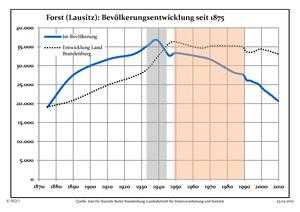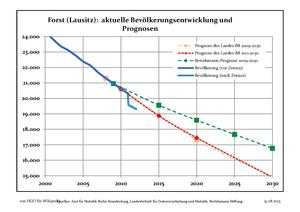Forst (Lausitz)
| Forst (Lausitz) | ||
|---|---|---|
 | ||
| ||
 Forst (Lausitz) | ||
Location of Forst (Lausitz) within Spree-Neiße district _in_SPN.png) | ||
| Coordinates: 51°44′N 14°38′E / 51.733°N 14.633°ECoordinates: 51°44′N 14°38′E / 51.733°N 14.633°E | ||
| Country | Germany | |
| State | Brandenburg | |
| District | Spree-Neiße | |
| Government | ||
| • Mayor | Jürgen Goldschmidt (FDP) | |
| Area | ||
| • Total | 109.91 km2 (42.44 sq mi) | |
| Elevation | 72 m (236 ft) | |
| Population (2012-12-31)[1] | ||
| • Total | 19,312 | |
| • Density | 180/km2 (460/sq mi) | |
| Time zone | CET/CEST (UTC+1/+2) | |
| Postal codes | 03141–03149 | |
| Dialling codes | 03562 | |
| Vehicle registration | SPN | |
| Website | www.forst-lausitz.de | |
Forst (Lausitz) (Lower Sorbian: Baršć) is a town in Brandenburg, Germany. It lies east of Cottbus, on the river Lausitzer Neiße which is also the German-Polish border, the Oder-Neisse line. It is the capital of the Spree-Neiße district. It is known for its rose garden and textile museum. The town's population is 20,618. In Forst, there is a railway bridge across the Neiße belonging to the line Cottbus–Żary which is serviced by regional trains and a EuroCity train between Hamburg and Kraków (2011). There is also a road bridge across the river north of Forst.
Overview
Part of the region of Lusatia, Forst was awarded to the Kingdom of Prussia in the 1815 Congress of Vienna. The town was subsequently administered within the Province of Brandenburg. After World War II it became part of the German Democratic Republic.
Forst has experienced severe problems as a result of the 1990 German reunification, most notably from extreme unemployment. In the past, the town was known for textile manufacturing, but all of the textile plants and factories have closed down in recent years.
Demography
-

Development of Population since 1875 within the Actual Boundaries (Blue Line: Population; Dotted Line: Comparison to Population Development of Brandenburg state; Grey Background: Time of Nazi rule; Red Background: Time of Communist rule)
-

Recent Population Development (Blue Line) and Forecasts
People
- Hugo Baum (1867 - 1950), botanist
- Georg Thomas (1890–1946), general
- Bruno Kastner (1890–1932), actor
- Max Seydewitz (1892–1987), politician
- Brigitte Frank, née Herbst (1895–1959), wife of Hans Frank
- Erich Neumann (1892–1948), politician
- Werner Heyde (1902–1964), physician
- Georg Bose (1921–2011), German soldier during WWII, Knight's Cross of the Iron Cross recipient
- Günter Nooke (born 1959), politician
- René Rydlewicz (born 1973), footballer
- Ronny Scholz (born 1978), cyclist
References
- ↑ "Bevölkerung im Land Brandenburg nach amtsfreien Gemeinden, Ämtern und Gemeinden 31. Dezember 2012 (XLS-Datei; 83 KB) (Einwohnerzahlen auf Grundlage des Zensus 2011)". Amt für Statistik Berlin-Brandenburg (in German). 31 December 2012.
External links
-
 Media related to Forst (Lausitz) at Wikimedia Commons
Media related to Forst (Lausitz) at Wikimedia Commons - Official website of Forst (Lausitz) (German)
- Forst's Rose Garden (German)
-
 "Forst". Encyclopædia Britannica (11th ed.). 1911
"Forst". Encyclopædia Britannica (11th ed.). 1911 -
 "Forst". New International Encyclopedia. 1906.
"Forst". New International Encyclopedia. 1906.
.png)